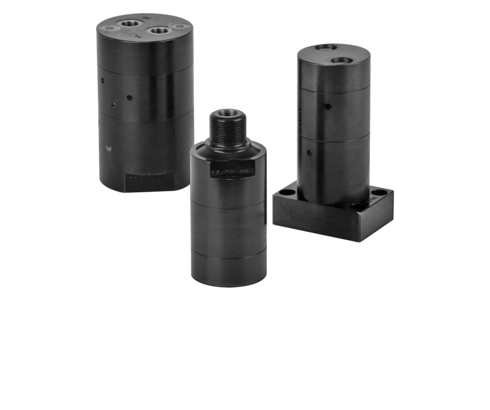Intensifier 0.2 – 2.6 l/min
max. operating pressure up to 500 bar
double acting
Description
An oscillating pump piston, that will be automatically reversed in the end positions by a hydraulically-operated valve, is installed in the intensifier. The ratio of the piston areas corresponds to the intensification ratio.
For unhindered flow in the low-pressure range, the pump piston will be bypassed by means of a bypass-line. A pilot-controlled check valve shuts off the high pressure.
Function
The flow rate is supplied without pressure through input IN via the check valves RV1, RV2 and DV to the output H and thereby to the hydraulic cylinders. With increasing counter pressure the oscillating pump OP starts working. The flow rate at output H is getting smaller and smaller and is nearly zero when reaching the maximum operating pressure.
The pump holds constant the pressure at H as long as low-pressure is available at IN. Between the ports IN and R there will be leakage of approx. 50 cm3/min, since due to functional reasons the pump elements cannot be sealed without leakage.
To retract the cylinders, port IN will be depressurised and port R pressurised. At the same time, the check valve DV will be opened and enables free return flow.
Single-acting cylinders
If only single-acting cylinders are connected, a double-acting valve function is required to control the pilot-operated check valves for unclamping (see hydraulic circuit diagram).
Important notes!
The intensifier can produce extremely high hydraulic pressures. The manufacturer of the system must provide effective safety valves for protection against excessive pressures.
The connection of the intensifier must always be double acting. For oil supply, port R must be depressurised. Pump piston and valve slide are fit with minimum clearance. In order to permanently secure the function, it is imperative to install a high-pressure filter at the input IN of the intensifier (see hydraulic circuit diagram).
As long as pressure is available at IN, the intensifier has an internal leakage between the ports IN and R. If no pressure is available at IN, the pressure can drop in the high-pressure area in case of a leakage.
By the installation of a pilot-controlled check valve at port H a pressure drop is avoided (see hydraulic circuit diagram). This applies in particular to uncoupled systems (clamping pallets).
| Item no. | CAD data | type | type | functioning | hydraulic port | |
|---|---|---|---|---|---|---|
|
Item no.
|
CAD data
|
Properties
| ||||
|
Item no.
|
CAD data
|
Properties
| ||||
|
Item no.
|
CAD data
|
Properties
| ||||
|
Item no.
|
CAD data
|
Properties
| ||||
|
Item no.
|
CAD data
|
Properties
| ||||
|
Item no.
|
CAD data
|
Properties
| ||||
|
Item no.
|
CAD data
|
Properties
| ||||
|
Item no.
|
CAD data
|
Properties
| ||||
|
Item no.
|
CAD data
|
Properties
| ||||
|
Item no.
|
CAD data
|
Properties
|
| Item no. | CAD data | Description |
|---|---|---|
|
Item no.
|
Description
Intermediate flange with filter screen
as per data sheet D8.756
|
|
|
Item no.
|
CAD data
|
Description
Hexagon nut M24 x 1.5 mm - DIN 936
as per data sheet D8.756
|
|
Item no.
|
CAD data
|
Description
Mounting bracket for intensifier
as per data sheet D8.756
|
Take advantage of the free benefits of our login area:
- CAD data download
- Download operating instructions
Welcome back! Log in to your already existing user account.
